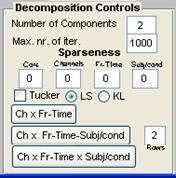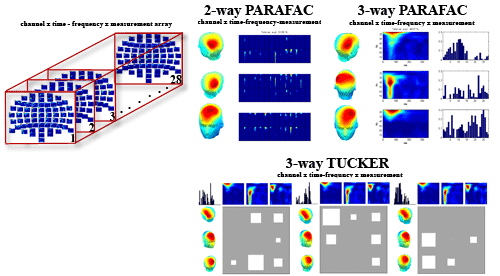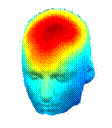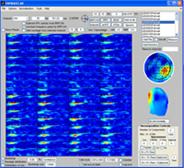|
The Decomposition Controls |

|
Example op a 2-way PARAFAC, 3-way PARAFAC and 3-way TUCKER decomposition of the ITPC of 28 files. |


|
Developed by Morten Mørup |
|
A tOOLbox FOR MULTI-CHANNEL TIME-FREQUENCY ANALYSIS |





|
Number of Components |
Specifies the number of components used in the model |
|
Max. nr. of iter. |
Specifies the maximum number of iterations used for the decompositions. |
|
Sparseness |
Core: Gives the sparseness imposed on the core Channels: Gives the sparseness imposed on the channel modality Fr.Time: Gives the sparseness imposed on the time-frequency modality Subj/cond: Gives the sparseness imposed on the 3rd modality containing the indices of the loaded datasets |
|
Tucker |
When checked, the TUCKER model is used else the PARAFAC model |
|
LS |
Least square minimization |
|
KL |
Kullback-Leibler divergence |
|
Ch x Fr-Time |
Decompose the currently selected data set into time-frequency signatures and channel mixings. |
|
Ch x Fr-time-Subj/cond |
Decompose all the data set into signatures of most common channel activation while the time-frequency signatures are kept specific for each dataset . Rows specifies how many rows are used to display the time-frequency signatures. |
|
Ch x Fr-Time x Subj/cond |
Decompose all the data set into signatures of most common channel activation to the most common time-frequency signatures and give the strength in which these signatures are present in each datasets. |